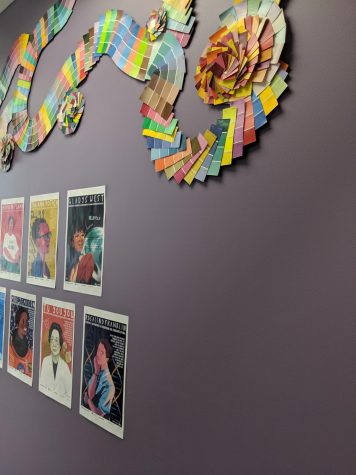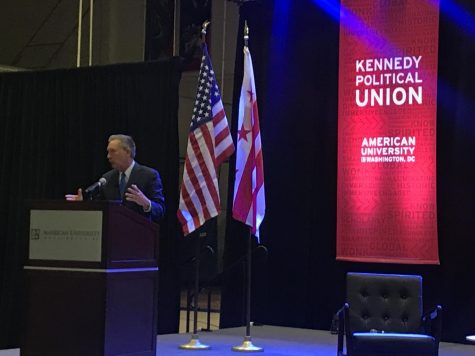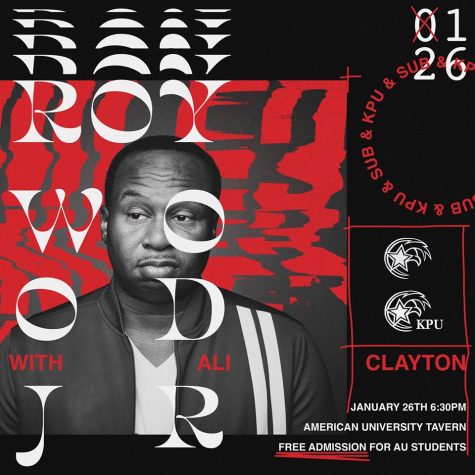From phone to fork
Jack Vogtle sits in a metal chair in front of the Davenport Coffee Lounge at American University. Even though he leaves his backpack on when he sits down, he seems instantly comfortable.
Over the summer, Vogtle was a bike courier for Postmates, a food delivery application for mobile devices, while he waited for security clearance for an internship at the Transportation Security Administration (TSA). Vogtle can’t stop smiling under his knock-off Ray Bans as he talks about the six weeks that he worked there. His voice cracks every time he gets excited, which is often.
“Ever seen ‘Premium Rush’?” Vogtle, 20, asked, referencing the 2012 movie starring Joseph Gordon Levitt riding his bike all over New York City’s busy streets. Vogtle leaned forward in his chair. “It’s like, sometimes you’ll get into this mode where you’re like ‘I’m so badass right now! I’m delivering this McDonald’s and it’s so important.’”
Those McNuggets and fries aren’t just important to Vogtle, either. All over Washington and across the country people are using delivery apps like Postmates to order and receive any type of food at all hours.
DC residents have a bevy of apps literally at their fingertips, including Postmates, Seamless, Instacart, EAT24, GrubHub, Drizly and Klink. The Apple App Store yields 915 results in a search for “food delivery,” each offering the fastest, cheapest, or otherwise best experience than the app one swipe to the right. EAT24 is perhaps the most succinct at putting its service into words, using the tagline, “Like a food truck in your pants.”
In a 2013 survey by Viggle and the Interactive Advertising Bureau (IAB), 69 percent of respondents placed an order for food using a mobile app, according to Kristina Sruoginis, research director at IAB. This trend is showing no signs of slowing down, rather, it’s booming in cities across the country.
No one knows this better than Nikki Rappaport. For her, delivery services mean good money. Rappaport, 27, is the brand strategist at Cava Mezze Grill, a fast food Mediterranean restaurant that opened its doors in 2006. Now it is a chain restaurant and brand known throughout the region with five locations and three more stores in the works. Over a half-eaten lamb and rice bowl, Rappaport explained how delivery apps offer companies nothing but a profit.
Postmates in particular allows more customers to eat at Cava than are physically able to visit, and it asks nothing in return from the restaurant. Rappaport compared the lesser-known app’s burgeoning success to that of Uber, the hugely popular taxi app.
“You don’t have to pick up a phone and call somebody, or go outside and raise your hand to hail a cab, so there’s that part that makes it easy,” Rappaport said, gesticulating and showing off her tangerine manicure. “The power is back on you to be able to do what you want with your time.”
With that, Rappaport recalled a time before. A time before phones were also computing devices, a time before it was possible to have restaurant food in your home within the hour without having to take a step outside or even make a phone call. As a millennial, Rappaport herself may be too young to clearly remember such a time, but it wasn’t so long ago.
Six years ago, the first apps were launched by Apple concurrently with the first iPhone. There were a mere 500 apps in the first app store, including the staples that still come with iPhones and have been adapted in the rise of android phones.
In 2009, the BBC published an article by Maggie Shiels about the rise of the then-new mobile application. The headline forecasted “Apps ‘to be as big as internet.’” The article projected that in just 10 years, applications would become as or more popular than Internet websites. In the same year, Vic Gundotra, a vice president at Google, said that he believed apps were a passing fad.
“Many, many applications can be delivered through the browser and what that does for our costs is stunning,” Gundotra stated in a Financial Times report. “We believe the web has won and over the next several years, the browser, for economic reasons almost, will become the platform that matters.”
Marlene Morris Towns, a professor of marketing at Georgetown University, tends to disagree with Gundotra’s 2009 assessment. From her sunny office overlooking a small but pristine courtyard next to the McDonough School of Business, Towns, 45, confidently postulates that the app is here to stay.
“I think that the whole app space is going to keep growing,” Towns said beneath a canvas print of Audrey Hepburn as Holly Golightly that hangs beside her door. “The requirements might amp up, people might expect more—in order for you to stick around and be on my main screen, you’ve got to really add some value.”
If anyone would know, it might be Towns. She has a PhD in marketing from Duke University, and wrote her 1999 dissertation on web marketing, making her among the earliest researchers in the field. Now she focuses on social media marketing in most of her courses.
App culture may have been described as a fad years ago, or even today, but Towns explained that there are many aspects of goods and services that may at first appear to be trends, but then prove their worth and remain a part of consumer culture. One product that fits this trend is hybrid cars, like the Toyota Prius, which Towns remembers as exploding in popularity after Larry David from “Curb Your Enthusiasm” started driving one on the show in 2003.
Already market research from the IAB and Viggle see people using mobile apps to buy their food and become increasingly likely to order with them as desired services become available. For example, 47 percent of people surveyed said they would be more likely to order if they got delivery alerts, 36 percent if the app could remember past orders and 23 percent if their apps could remember credit card numbers, according to Sruoginis.
These features are already becoming available and even widespread among delivery apps, and so the trend of using apps to buy dinner from cars, couches or the gym is still growing rapidly. Apps have already proven not to be a fad, but a burgeoning business model with staying power.
Jack Vogtle had to stop working for Postmates when his bike was stolen from a rack outside the Tenleytown Metro station on his first day interning at the TSA. He never bought a new bike, but he looks back on his time at Postmates fondly and without regret. He sees a bright future for delivery apps as they build momentum in Washington.
“Whenever I told someone I was bike courier-ing, they were like ‘What do you mean?’” Vogtle said, as he grinned widely, leaning back and crossing his arms over his blue Team Italia soccer jersey. “And I was like, ‘Have you not heard of this wondrous world where I can deliver you whatever you want?’











